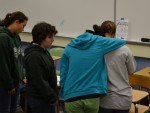InterACT: Time and Space to Learn and Reflect
Some thoughts prompted by ten days of Michael Brown, Jr., and Ferguson, Missouri in the news, and through interaction with many colleagues and acquaintances in various online communities, including #CAedchat …
What do we do in school communities when events of historic proportion take place? Or overwhelm us? What do we do when our communities are in grip of trauma, fear, or grief? How many ways are we willing to define, or redefine, “our community”?
I think we have to be willing to toss out the lesson plan, or revise it. This must be done thoughtfully and advisedly, of course. A teacher needs to know the students, the community, and have the skills and sense to manage whatever is about to replace the regular lesson. But certainly, if we place the lesson plan ahead of significant moments in our communal life, we not only rob students of a chance to learn something more lasting and potentially important, but we also unwittingly reinforce the oft-heard but incorrect message that school is separate from “the real world.”
Let me share a positive example first. When I was in fifth grade, Ronald Reagan was sworn in for his first term as President. That alone would be an event worth watching – on the small tv with the big antennae. Set aside spelling lists and geography for a while. The math lesson can wait an hour, or a day. (In 2009, I had the chance to watch the Obama inauguration with my American Literature classes, which made for an interesting study in the iconography and symbolism in American political rhetoric).
Then, of course, on that same inaugural day in 1981, the American hostages were released from Iran. Our principal asked us to bring the American flags out of our classrooms to display in front of the school, to show our patriotism and celebrate that the hostages were coming home.
I can’t tell you any specific academic content I learned that year, except maybe that Louisiana is The Pelican State; I did a report on it. That may have been the first time I learned anything about Louisiana. Certainly, I learned and practiced some other skills that year. I probably made adequate yearly progress. After all, I went on to 6th grade with no struggles, and so on and so forth. (I’ve actually written about 5th and 6th grade before – a satirical Thanksgiving post, here).
What did I learn from watching the Reagan inauguration and participating in the patriotic display for our returning hostages? I understood on some level (that I probably could have articulated even then, had I been asked), that I was part of America, that I should know how our government works, and that I should show thanks for the safe return home of my fellow citizens.
Six years later, there was a tragedy: the space shuttle Challenger exploded shortly after liftoff. I was on my way to physics class when one of my friends told me. Our teacher didn’t expect us to study physics that day – not in the expected, planned, or assessed ways, at least. We watched the tv again – I think there was cable by then – and again, I felt connected to a broader community, but in grief.
Do we, collectively, feel connected to the events in Ferguson, MO? Should we? Should our students?
Here’s the way I see it. With younger children, we actually have some influence over what they will remember, what they feel connected to. If my teachers and principals had ignored the events of 1981 and 1986, I would have less of a memory that they occurred, less of an authentic sense of meaning. My recollection of the events of January, 1981, are all connected to school, not home, not my synagogue. For some students, if we don’t talk about this, it will not be part of their memory of our country’s history. And for some students who will most certainly remember this time, we’ll have to explain why this particular event – and the tragic pattern in which it fits – that mattered so much to them, was not worth our time, not considered educationally relevant.
It’s true that events like this present us with a complex narrative, one that exposes divides and uncomfortable truths about our nation – legacies of violence and discrimination going back centuries, still unreconciled. Talking about these issues in the classroom may be daunting for some: it’s difficult for many of us to bring up even in passing, among adults. Or maybe I should say, it’s difficult to talk about for those of us who have the privileged option to ignore race in America when we choose to. If we don’t talk about Ferguson, about the life and death of Mike Brown, Jr., then we miss an opportunity to help our students understand and develop a connection to their country’s living history. That’s not something we cherish – the recognition of seemingly perpetual conflict – but if we ignore it, we don’t equip students to deal with it any better in the present or the future.
I titled this post “Time and Space to Learn and Reflect.” That’s my hope for students in the coming days and weeks – that they’ll have time and space, in school, to learn about and reflect upon what’s happening in the country right now. Teachers, administrators, parents and community members – we all need to see this as part of our work. We pledge allegiance to the flag of our Republic, affirming that it stands for a nation indivisible, with liberty and justice for all. If we believe that pledge, we are not to be divided from Ferguson, nor are we to ignore liberty restricted and justice denied. We have a duty to ask why, and must be brave enough to follow where such questions lead.
I’ll leave the means and methods for teachers and schools to figure out, the how, where, when and how much. There are many, many ways to address this topic, acknowledge what’s happening, make it a teachable moment that has both personal and academic relevance for students. It’s important both to make an effort, and to get this right. Don’t back off because you can’t do it perfectly, but make sure you handle well whatever aspects of it you address. I think it’s possible to provide a basic context and framework for some conversation with even young children, and then to provide appropriate levels of depth and complexity for older students. It is not likely to be a discussion or series of lessons that lead to clear outcomes, answers, resolution. We need to be okay with that. And of course, the conversation will vary depending on where it’s taking place – Staten Island, NY, or Bainbridge Island, WA; Sanford, FL, or Stamford, CT. But I hope anyone who’s read this far sees that we can’t just carry on, business as usual.
We have history to confront, many threads connecting the past and present; we have differences to reconcile, and a potential for unity worth striving for. Ferguson is our country, our legacy, and our challenge for the future – you know, the one our students will be helping us create.
This blog post has been shared by permission from the author.
Readers wishing to comment on the content are encouraged to do so via the link to the original post.
Find the original post here:
The views expressed by the blogger are not necessarily those of NEPC.


